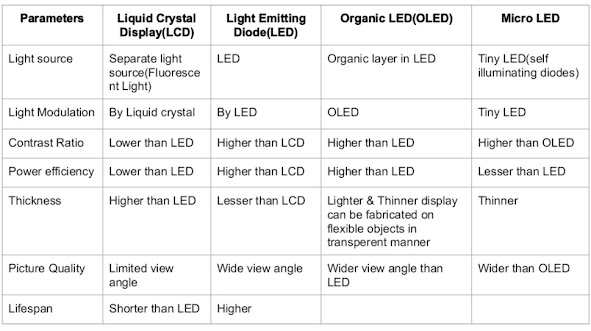Lecture 10 Computer, Display and Batteries
Computer
Supercomputer- Computer with a high level of performance as compared to a general purpose computer. The performance of a supercomputer is commonly measured in PETAFLOP (FLOPS- floating point operations per second) instead of million instructions per second(MIPS).
National Supercomputing Mission 2015 was launched with C-DAC Pune and IISc Banglore as implementing agency.
India’s first supercomputer was PARAM 8000.
PARAM Shivay, the first indigenously assembled supercomputer was installed in IIT BHU, followed by PARAM Shakti(IIT-Kharagpur), PARAM Brahma(IISER, Pune).
Quantum Computer- Quantum computer take advantage of quantum mechanics to solve complex problems that classical computers or supercomputers can't solve. The basic unit of information in quantum computing is qubit/quantum bit which serves the same function as the bit in classical computing. Qubit can exist in more than one state at the same time. In quantum computer power increase exponentially with increase in number of qubits. Quantum computer will support the development of machine learning and artificial intelligence.
Characteristics of Quantum computer-
- Superposition- qubits can exist in a superposition of 0 and 1 simultaneously.
- Entanglement- Two qubits cannot be described independently. Change in one qubit affect other entangled qubit.
- Tunneling- Ability of particles to tunnel through barriers
- Decoherence- Decoherence is the loss of a qubit's quantum state. Environmental factors, such as radiation, can cause the qubits quantum states to collapse.
- Supremacy- Quantum supremacy, also known as quantum advantage, refers to quantum computers' ability to solve problems that classical computers cannot.
Artificial Intelligence- Ability of a machine to imitate intelligent human behavior. In 1956, John McCarthy organised Dartmouth Conference and under it coined the term Artificial intelligence.
Machine Learning- Application of AI that allows a machine/system to learn automatically and improve from experience.
Deep Learning- Subset of machine learning that uses vast volumes of data and complex algorithms to train a model. It uses Neural Networks(similar to the neurons working in our brain) to mimic human brain-like behavior.
Biological computers- It uses biologically derived molecules such as DNA and proteins to perform digital or real computations
DNA computer- It uses DNA, biochemistry, and molecular biology hardware, instead of the traditional electronic computing hardware.
Artificial Intelligence Governance-
Global Partnership on Artificial Intelligence(GPAI)- Launched in 2020 and hosted by OECD.
Bletchley Declaration(UK, 2023)- First global pact on tackling frontier AI risks.
Hiroshima AI Process(G7, 2023)- International discussions on inclusive AI governance.
Delhi Declaration of the GPAI(India, 2023)- To harness new opportunities and mitigate the risks arising from the development, deployment, and use of Artificial Intelligence(AI). Main issues with AI are
- Misinformation- False information regardless of intent to mislead.
- Disinformation- False information with the intent to mislead.
- Deep Fake- Use of AI to manipulate or generate visual and audio content with the intention of deceiving or misleading someone. Deepfakes are created using a technique called Generative Adversarial Networks(GANs), which involve two competing neural networks: a generator and a discriminator.
Artificial Intelligence Preparedness Index(AIPI)- Index developed by IMF to track the AI readiness of economy globally.
Youth for Unnati and Vikas with AI(YUVAi)- Launched by National e-Governance Division(NeGD) + Intel India to foster a deeper understanding of AI by imparting AI knowledge to school students(from classes 8 to 12) of India.
Artificial Intelligence Research, Analytics and Knowledge Assimilation Platform(AIRAWAT)- Cloud computing platform released by NITI Aayog, India
Cybercrime-
Criminal activities conducted via the Internet or involving computer systems.
Modes of Cybercrime
- Malware- Software designed to harm or exploit computers and networks.
- Hacking- Unauthorized access to computer systems and networks by use of malware.
- Phishing- Fraudulent attempts to obtain information by pretending to be a trustworthy entity by using malware.
- Cyberstalking- Harassment or stalking conducted online.
Budapest Convention(2001)- Convention against cybercrime came into effect in 2004. India is not signatory of Budapest Convention.
Evolution of the World Wide Web-
Web 1.0(read only web)- Tim Berners Lee created the World Wide Web in 1989 at CERN. In Web 1.0, users have access to view material only. Web 1.0 was dominated by Static website.
Web 2.0(read-write web)- more interactive web and focused on user generated content, usability and interoperability for end users thus making it participative social web. Blog, social media and video streaming gained popularity.
Web 3.0(read-write-execute web)- web data in machine readable format leading to machine to machine interaction to support AI and machine learning. Web 3.0 is also referred as Semantic Web. Rise of distributed ledgers and blockchain storage technology will enable data decentralization and the creation of a transparent and secure environment on Web 3.0.
Display Technology
Battery
Electric battery- A device that stores chemical energy and converts it into electricity.
Parts- Electrodes(Anode and Cathode), Electrolyte
Major type of batteries
- Solid state battery- It is a battery that uses solid electrodes and a solid electrolyte. Because of solid state electrolyte these batteries are more safer than other batteries.
- Nickel Cadmium battery
- Alkaline Battery- zinc and manganese dioxide as electrodes.
- Lithium ion Battery- widely used at present



Comments
Post a Comment